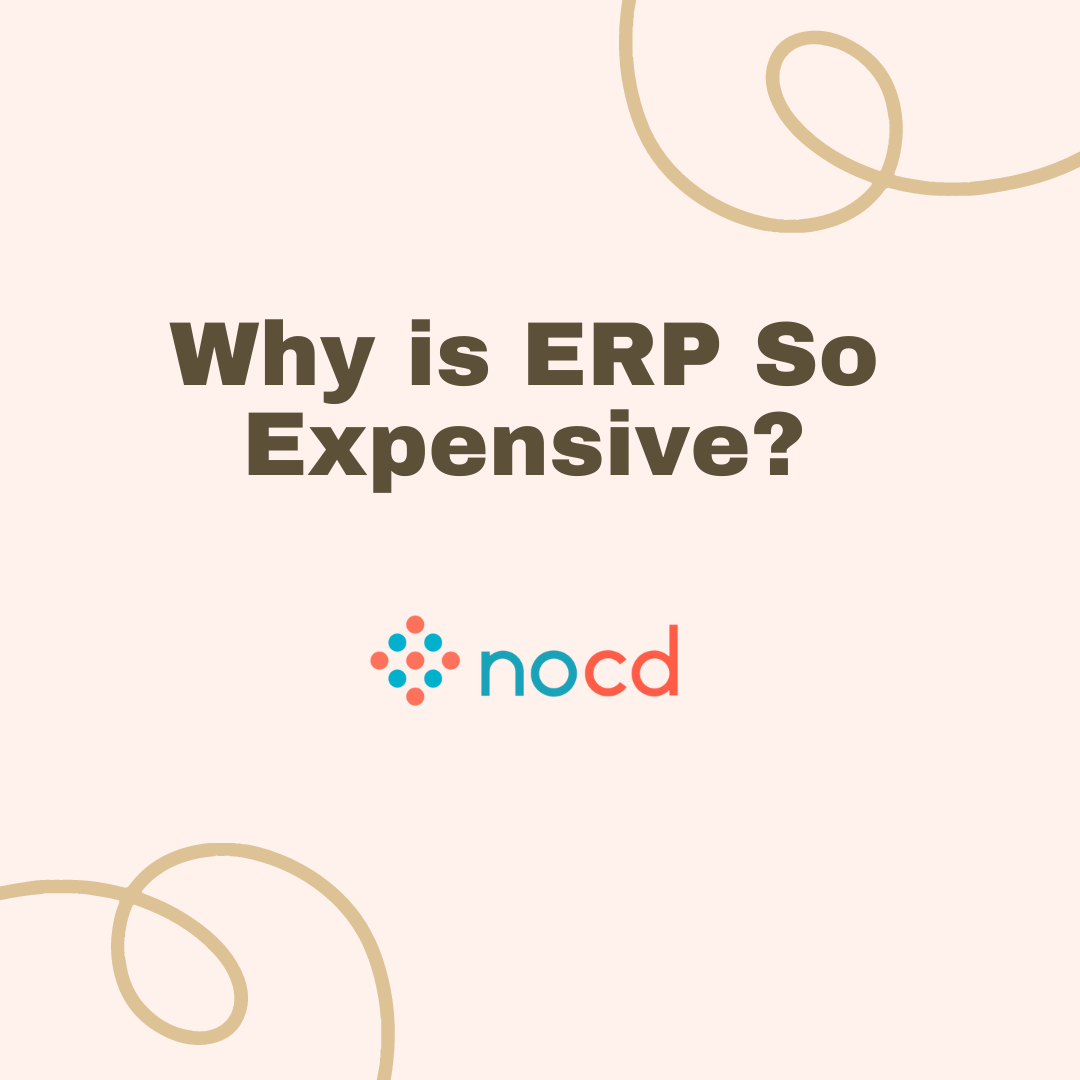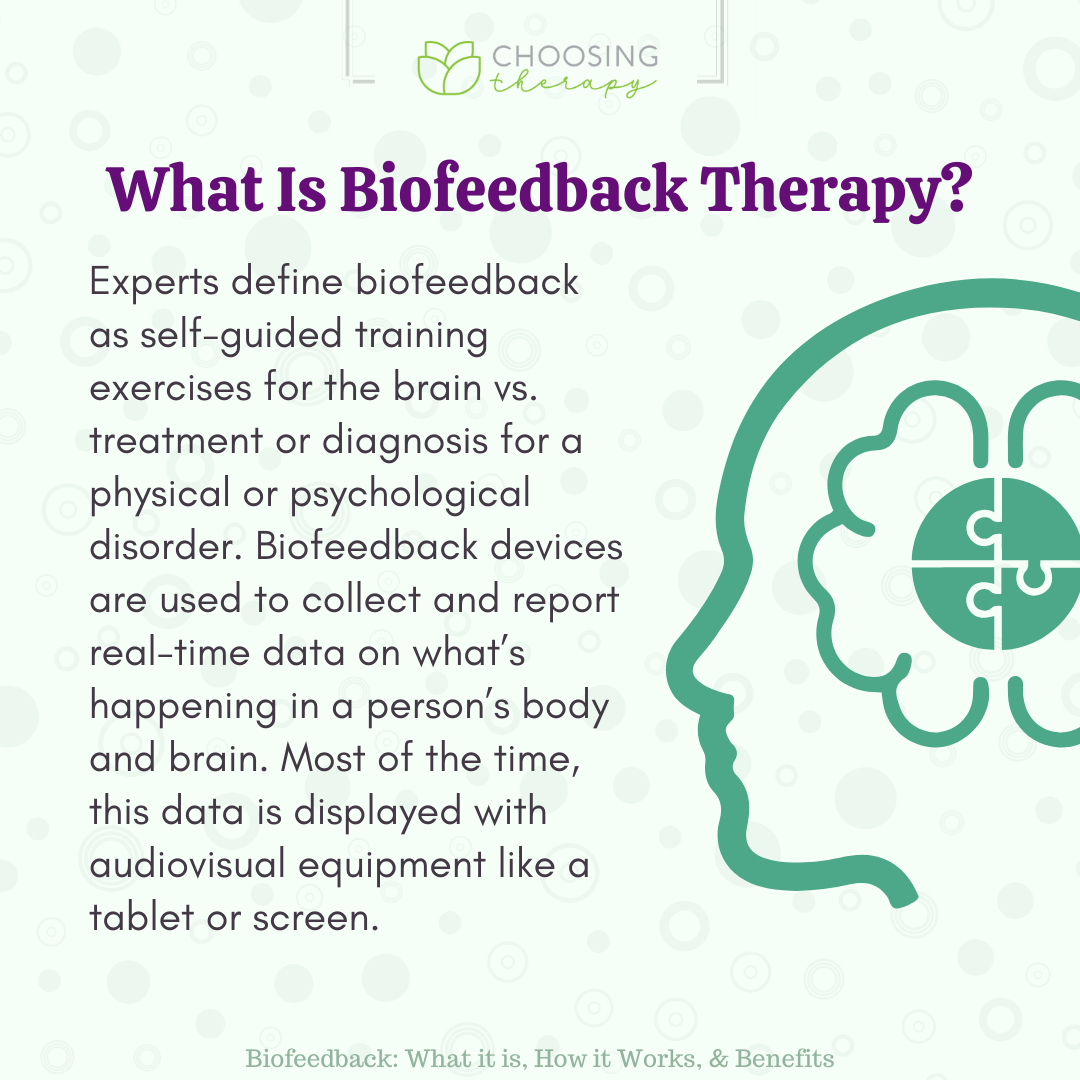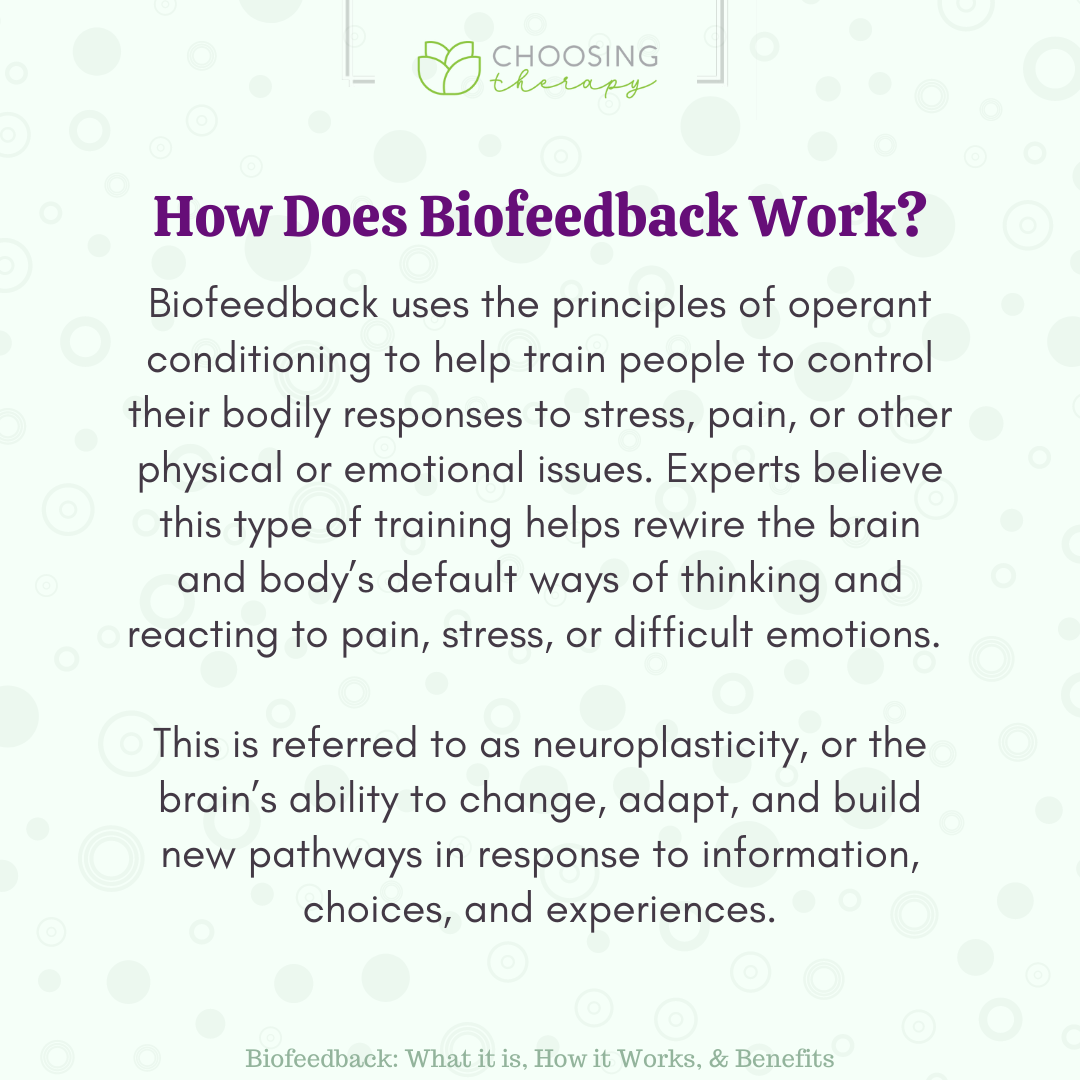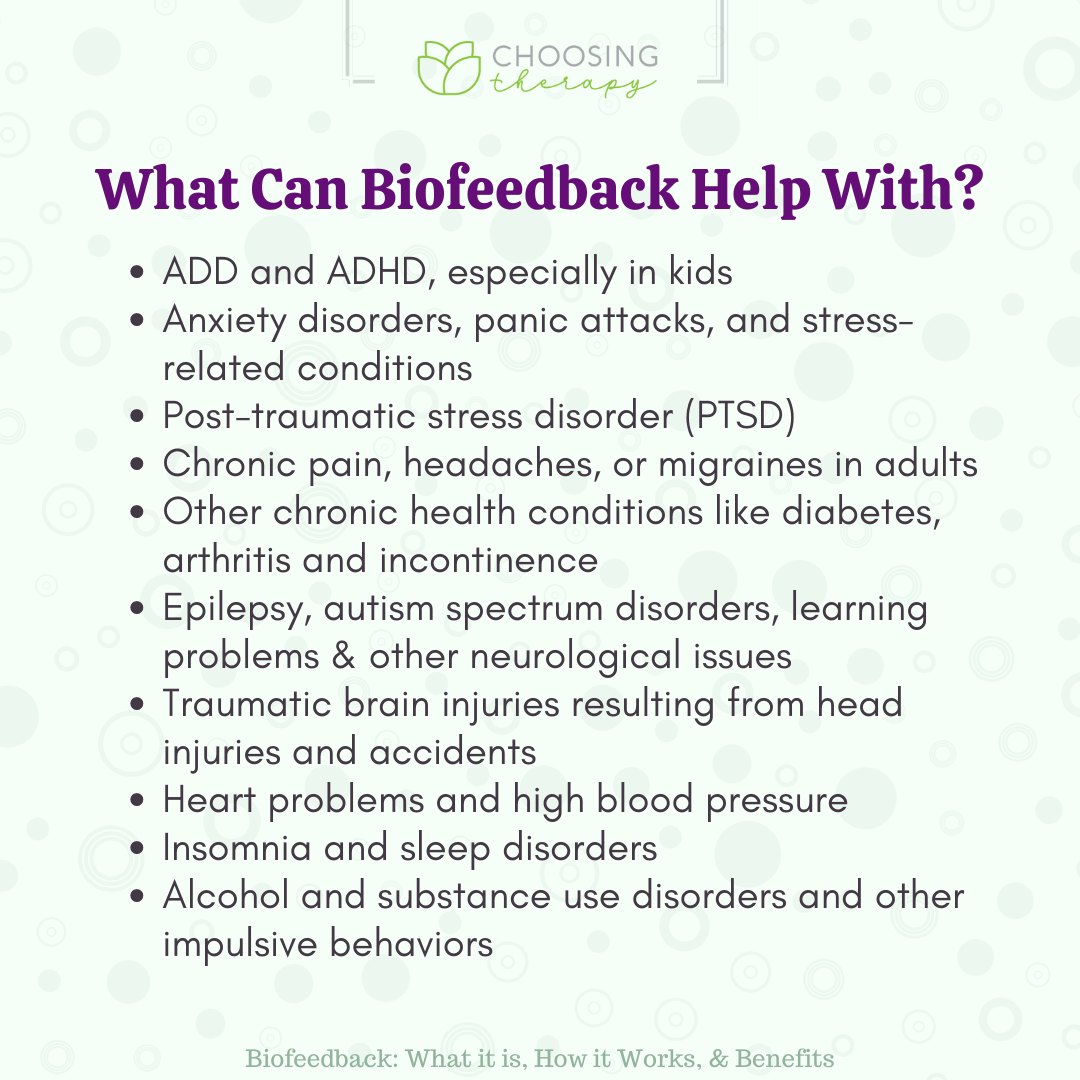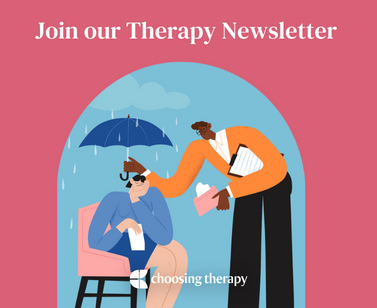Biofeedback monitors and provides real-time data on someone’s heart rate, breathing, sweat, muscle tension, brain waves, and other physiological responses.1,2,3 Biofeedback devices help people learn to control these involuntary bodily processes to improve their physical and mental health. Different types of biofeedback are used to improve symptoms of conditions like stress, anxiety, ADHD, PTSD, and chronic pain.2,4,5
Would you like to try therapy? Find a supportive and compassionate therapist! BetterHelp has over 20,000 licensed therapists who provide convenient and affordable online therapy. BetterHelp starts at $65 per week. Take a Free Online Assessment and get matched with the right therapist for you.
What Is Biofeedback Therapy?
Experts define biofeedback as self-guided training exercises for the brain instead of treatment or diagnosis for a physical or psychological disorder.1,2,3 Biofeedback devices are used to collect and report real-time data on what’s happening in a person’s body and brain.1,2 Most of the time, this data is displayed with audiovisual equipment like a tablet or screen. Most biofeedback sessions are computerized and require minimal involvement from a licensed health or mental health provider.1,2,3,6
During a biofeedback session, a person may sit in front of a screen that shows their heart rate, blood pressure, or brain wave activity. Depending on the activity, they will be prompted by the screen to complete a certain task, activity, or skill to help them learn how to change these responses.3,5 Over time, biofeedback helps people learn how to control bodily processes that contribute to issues like stress, anxiety, or chronic pain.1,2,5,6
Will I Need Other Treatments, Too?
Biofeedback is often combined with traditional treatments including talk therapy, cognitive behavioral therapy (CBT), or mindfulness and relaxation training.3 When combined with other treatments, biofeedback has proven to help people manage symptoms of chronic stress, anxiety disorders, mood disorders, and attention deficit disorders. Some studies also show that certain types of biofeedback can help people struggling with certain health conditions like chronic pain, incontinence, and seizure disorders.1,2,5
“Biofeedback and Neurofeedback have been in operation for more than 50 years as a means of self-regulation. Reviews of studies over the years indicate biofeedback can reduce stress and have efficacy and neurofeedback has been considered ‘Efficacious and Specific (level 5) for ADHD.’ Epilepsy reduction was one of the bases for the development of neurofeedback. Alpha/theta enhancement was and is used for addiction issues. The use of stimulation and light therapy has evolved as additions to the simple biofeedback and neurofeedback training with more rapid resolution of brain dysregulation.
I have been providing neurofeedback training for 39 years and have seen clients return fully functioning after a series of training. I use Event-Related Potential tasks as well as static eyes closed, and eyes opened to assess the brain’s dysregulation and formulate protocols to address the issues. Psychotherapy is an intricate part of the training to address the issues that are impeding the happiness of the client. Biofeedback and Neurofeedback work.” – Merlyn Hurd, PhD, Psychology P.C., QEEG-D, BCN, BCB, Board Certified Neurotherapist & QEEG analyst
How Does Biofeedback Work?
Biofeedback uses the principles of operant conditioning to help train people to control their bodily responses to stress, pain, or other physical or emotional issues.1,2,3,5 Experts believe this type of training helps rewire the brain and body’s default ways of thinking and reacting to pain, stress, or difficult emotions. This is referred to as neuroplasticity, or the brain’s ability to change, adapt, and build new pathways in response to information, choices, and experiences.1,5
What Devices Are Used for Biofeedback?
Biofeedback devices range from low-tech sensors that monitor heart rate, blood pressure or respiration to high-tech medical devices including EEG’s and MRI’s that involve placing sensors on your head or using a large imaging machine.1,3
EMDR & Alternatives To Traditional Therapy Self-Guided Online EMDR Program – Expert-developed EMDR program. 9 in 10 people feel less Emotional Distress after just one session. Free Trial – VirtualEMDR Ketamine Program For Depression, Anxiety, and Trauma – Nue.life offers an at-home, evidence-based ketamine program supported by hundreds of clinical studies. Our clients feel rapid & lasting relief within hours after the first treatment. Learn More
Types of Biofeedback Therapy
There are a variety of different options for people interested in biofeedback therapy, including a range of devices used in medical and non-medical settings. Some biofeedback treatments occur in medical or mental health clinics, but new technology has also made it possible for people to do biofeedback at home. Most biofeedback devices are non-invasive, painless, and generally safe, without many known adverse effects.3,5
Depending on the issue or problem they’re trying to improve, different kinds of biofeedback treatments may be recommended.
Common types of biofeedback include:
- Electromyography (EMG): This type of biofeedback involves the use of EMG to monitor electrical activity and muscle responses in the body. This kind of biofeedback is popular because it can track several different physiological changes at once, including muscle tension and nerve cell activity.1,2,3,5
- Respiratory biofeedback: This type of biofeedback monitors respiration and breathing by using bands placed around the abdomen and chest. The goal of respiratory biofeedback is usually to teach people how to control and regulate their breathing. It may be used for people with asthma, anxiety, breathing issues, or panic symptoms.1,3,6
- Heart rate & blood pressure biofeedback: These types of biofeedback measure your heart beat, rhythm, and blood pressure using sensors on the ears, finger, wrist, arms, or chest. The goal of heart biofeedback is often to help people learn how to regulate their heart rate and blood pressure to reduce symptoms of anxiety or risk of cardiovascular problems.1,2,3,6
- Skin response & thermal biofeedback: Some biofeedback therapy involves using sensors placed on the skin to measure skin temperature and sweating. This may be useful for people who notice they become hot, cold, sweaty, or chilled when they experience symptoms.1,2,3,6
- Neurofeedback: Neurofeedback measures brain wave activity using painless electrode sensors on the head while a person is engaged in different activities on a screen. This kind of biofeedback is gaining recognition as a separate branch of biofeedback. It’s often used to help treat attention deficit disorder (ADD) and attention deficit/hyperactivity disorder (ADHD) (especially in kids), neurological and cognitive problems, and seizures.1,2,3
- Computer-assisted biofeedback: Today, many biofeedback therapy sessions involve the use of computerized technology that’s linked to the sensors tracking changes in your body and brain. For example, it’s not uncommon to be set up for sessions in a chair with headphones and a large touchscreen that gives you different prompts, games, activities, and images.1
- Psychophysiological psychotherapy: This kind of biofeedback includes the use of biofeedback devices as well as a licensed therapist or counselor to guide the treatment. The therapist may be there as a support person providing suggestions, skills, or prompts, or the treatment could involve a mix of biofeedback and more traditional talk therapy.6
- Virtual therapy with home biofeedback devices: Because of the growing popularity and accessibility of online therapy sessions, some therapists are now incorporating biofeedback into online therapy. Clients who have wearable biofeedback devices that measure heart rate, brain waves, or even use virtual reality are being incorporated into therapy sessions. Early results for people with substance use disorders have shown promising results.7
When Is Biofeedback Therapy Used?
While biofeedback isn’t considered an actual treatment for medical or mental health conditions, it can be effective as a complementary approach, especially for people interested in holistic or alternative health.5 More research has been conducted in the past decade that helps legitimize biofeedback as an effective treatment for a range of different health and mental health disorders. Dr. Hurd mentions, “The armed forces successfully use neurofeedback with veterans returning with PTSD and other mental health issues.”
According to studies, biofeedback (including neurofeedback) can help people with conditions like:1,3,6
- ADHD, especially in kids
- Anxiety disorders, panic attacks, and stress-related conditions
- Post-traumatic stress disorder (PTSD)
- Chronic pain, headaches, or migraines in adults
- Other chronic health conditions like diabetes, arthritis and incontinence
- Epilepsy, autism spectrum disorders, learning problems & other neurological issues
- Traumatic brain injuries resulting from head injuries and accidents
- Heart problems and high blood pressure
- Insomnia and sleep disorders
- Alcohol and substance use disorders and other impulsive behaviors
What Are the Benefits of Biofeedback?
Many people who opt for biofeedback are looking for non-invasive, safe, holistic ways to improve their health.2,5 A major advantage of biofeedback is that it’s safe, with few people reporting any side effects.3 Biofeedback aims to help people learn how to control and manage their own physical and mental health, rather than relying on medications or treatments from specialists.5
Physical Benefits of Biofeedback
The physical benefits of biofeedback depend on the type of training a person receives and the particular issue or problem they’re trying to improve. Many people who seek biofeedback for a chronic health or medical condition hope to gain more control over their symptoms or reduce dependence on medications. Some want to manage conditions like high blood pressure or reduce their risk for heart conditions.5
Depending on a person’s reasons for seeking out biofeedback, the potential benefits include:1,2,3,5
- Feeling more in control of physiological responses like heart rate and blood pressure
- Fewer headaches including tension headaches and migraines
- Reduced dependence on more invasive treatments like medications
- Better sleep quality or improvements in insomnia
- Less muscle tension, soreness, or chronic back, shoulder or neck pain
- Fewer instances of urinary incontinence
- Improvements in chronic pain or health issues
- Faster recovery from injuries requiring physical rehabilitation
- Improved muscle and motor control
- Helping people feel more in control of their physical health
Mental & Emotional Benefits of Biofeedback
Because biofeedback is proven to help with stress management and cognitive functioning, not all people who receive this training have a mental health condition. Some may be motivated by a desire to reduce stress levels or improve cognitive functioning.3,4 Those with mental health conditions may receive biofeedback therapy that includes a combination of biofeedback and other treatments.1,2,3
The psychological benefits of biofeedback include:1,2,4
- Learning relaxation techniques or coping skills that improve mental wellbeing
- Improvements in ability to focus and concentrate (especially neurofeedback for ADHD)
- Better cognitive functioning, memory, or improvements in learning
- Having more control over mood, stress, and anxiety
- Reductions in symptoms of chronic conditions like OCD, PTSD, and depression
- Fewer urges and cravings for food, substances, or other addictive behaviors
- Improved impulse control and better decision making
Top Rated Online Therapy Services BetterHelp – Best Overall “BetterHelp is an online therapy platform that quickly connects you with a licensed counselor or therapist and earned 4 out of 5 stars.” Visit BetterHelp Talkspace - Best For Insurance Talkspace accepts many insurance plans including Optum, Cigna, and Aetna. Typical co-pay is $30, but often less. Visit Talkspace
Are There Any Risks to Using Biofeedback?
Biofeedback is safe and non-invasive with few potential side effects. The only exception is that some people who receive neurofeedback using EEG or fMRI technology sometimes experience mild headaches or fatigue.3,4 While there are few risks, it’s important to understand that biofeedback isn’t a stand-alone treatment for any medical or psychiatric condition. It’s designed as a complementary process that can be combined with other research-backed therapies, medications, or treatments.3
Is Biofeedback Therapy Effective?
Biofeedback therapy can be very effective as a complimentary relaxation technique and somewhat effective on its own. In one study, it was noted that 86% of patients had improved anxiety and pain with relaxation techniques when used with biotherapy and only 50% of patients had improved anxiety and pain after biofeedback therapy alone. It was also noted that those who used relaxation techniques intermittently after biofeedback therapy had significant improvement in their symptoms of anxiety and pain.10 Biofeedback therapy is also effective for the treatment of depression and reducing symptoms long-term. Techniques for depression and interventions included breathing exercises to support the ongoing remission of depression.11
Examples of Biofeedback
There are many examples of biofeedback therapy that can impact both physical and mental health issues. Biofeedback can support mental health conditions such as anxiety and depression.
Biofeedback for Anxiety
In biofeedback therapy for anxiety, the first few sessions are aimed at learning your body’s baseline levels and how it responds to certain stressors. Sensors are placed on the body to track reactions to the conversations and stimuli that comes up from sessions. Muscle movement, vitals, and sweat production are aspects that may be measured, and these sessions can last up to an hour. Biofeedback can help to manage anxiety by helping you learn about how your body responds to certain stimuli.11
Biofeedback for Depression
Biofeedback for depression is just as helpful as for anxiety. Utilization of breathing techniques and tracking HRV on an ongoing basis can benefit the management of depression, reduce stress-related symptoms, and improve overall coping. Utilizing smart watches and tracking data on smartphones can be a great asset for this intervention. There is a correlation between HRV trends and depression symptoms, so being able to understand the connection in biofeedback therapy can prove to be very helpful.12
How to Find a Biofeedback Therapist
Finding a biofeedback therapist may involve a little more research than finding a therapist who uses more traditional methods of therapy. Many people begin their search online by using an online therapist directory that allows them to narrow their search by location and specialty areas of practice. It’s also a good idea to find someone who is BCIA credentialed, which means they’ve received additional training and certification in biofeedback.
If you’re looking for biofeedback to treat a mental health condition, it’s important to find a licensed therapist as not all biofeedback practitioners specialize in mental health. Some are medical professionals and others are technicians without formal training. You can use the AAPB’s website to find a BCIA therapist who specializes in treating the specific mental health issue you struggle with.
Can Biofeedback Be Done at Home?
Dr. Hurd states, “Home training is a desired issue and there are many instruments that are marketed to be used. One should consult with an expert therapist who can recommend the appropriate instrument for the client according to the QEEG findings performed by the therapist who is certified as a diplomate by the International QEEG Certification Board. FDA registered instruments are assessed for safety and need to be the first choice. The training can be conducted with children as young as 4 years old with various issues to older adults with cognitive and memory impairments.”
Cost of Biofeedback Therapy & Devices
The cost for biofeedback varies a lot depending on the type of devices used, where you receive the treatment, who administers it, and whether your insurance covers it. For example, receiving biofeedback from a licensed doctor, psychiatrist, or counselor often costs more, but may include other types of treatment. Still, biofeedback may be more cost-effective when provided by a non-licensed technician, especially for uninsured people.3,4
Does Insurance Cover Biofeedback Therapy?
Not all biofeedback is covered by mental health insurance, so it’s important to check with your insurer to verify costs ahead of time.3 On average, people self-paying for biofeedback sessions can expect to pay $35-$85 for a 30-60 minute session.8 Neurofeedback sessions often cost more because they require more expensive medical equipment, with a range of $50-$130 per session.9
Cost of Biofeedback Devices
There are some people who opt to buy their own biofeedback equipment, which may be more affordable, especially since some people require 20-40 sessions to see optimal results. The AAPB recommends only purchasing FDA-regulated biofeedback devices, which helps to ensure they are safe and effective.3
Still, many people have access to biofeedback equipment via their smartphones, tablets, or wearable devices like Fitbits or Apple watches. While these may not be as accurate as FDA-approved devices, they can provide basic monitoring of heart rate, respiration, and sleep quality.
What to Expect at Your First Appointment
During a biofeedback session, certain devices, biofeedback machines, and sensors are connected to a person’s skin. These sensors are painless and only used to monitor different responses in their body or brain during the session. These sensors convey information, usually by displaying it on a screen, tablet, or computer.1,3 Different types of biofeedback machines are used to track certain physiological information (like an EEG for brain waves or electrode sensors to monitor heart rate or breathing).
The person may be asked to complete different games, tasks, or videos on the screen to monitor changes in response to different activities. In the initial biofeedback session, the goal is to establish a person’s normal responses so their progress can be monitored over time. If the issue is psychological, a licensed professional may also conduct a diagnostic assessment.1
Future Biofeedback Sessions
Future sessions are more focused and individualized to the issues or problems a person has, but the goal is always to help people learn how to be in control of bodily responses in order to improve their physical or mental health. For example, someone with ADHD may be prompted to complete tasks that require focus like reading or math problems while someone with anxiety may be given a guided meditation.
By providing people with accurate ways to track their responses, they can learn to control certain bodily processes that were once believed to be involuntary. Because the feedback is immediate, people can see the direct effects of certain skills or activities (i.e., noticing their heart rate drops or brain waves slow when doing a guided meditation or using mindfulness skills.
How Many Sessions Will I Need?
Biofeedback session frequency will depend on individual needs. Typically, people usually receive 4-6 sessions, however that range can increase to 8-10 sessions. People who are presenting with several comorbidities may end up needing more, and the level of severity of symptoms can also inform the number of sessions someone may need.
Final Thoughts
Biofeedback isn’t used to diagnose or treat medical or mental health issues, but it can be combined with other treatments to help people manage their symptoms.1,2,3 Biofeedback training provides real-time feedback from medical sensors or devices that track heart, respiratory, brain activity, etc. Using this data, people can learn how to control responses and improve issues like chronic pain, ADHD, and mood and anxiety disorders.1,3,5,6
To help our readers take the next step in their mental health journey, Choosing Therapy has partnered with leaders in mental health and wellness. Choosing Therapy is compensated for marketing by the companies included below. Online Therapy BetterHelp – Get support and guidance from a licensed therapist. BetterHelp has over 20,000 therapists who provide convenient and affordable online therapy. Take A Free Online Assessment and get matched with the right therapist for you. Free Assessment Online Psychiatry Hims / Hers If you’re living with anxiety or depression, finding the right medication match may make all the difference. Connect with a licensed healthcare provider in just 12 – 48 hours. Explore FDA-approved treatment options and get free shipping, if prescribed. No insurance required. Get Started Medication + Therapy Brightside Health – Together, medication and therapy can help you feel like yourself, faster. Brightside Health treatment plans start at $95 per month. United Healthcare, Anthem, Cigna, and Aetna accepted. Following a free online evaluation and receiving a prescription, you can get FDA approved medications delivered to your door. Free Assessment Starting Therapy Newsletter A free newsletter for those interested in learning about therapy and how to get the most benefits out of therapy. Get helpful tips and the latest information. Sign Up Choosing Therapy Directory You can search for therapists by specialty, experience, insurance, or price, and location. Find a therapist today.Additional Resources
What Is Exposure and Response Prevention Therapy? ERP therapy alters OCD’s pattern by addressing both obsessions and compulsions. In ERP, an individual is encouraged to confront the stimuli that trigger distress related to their obsessions while also resisting the urge to perform compulsions in an attempt to reduce their distress.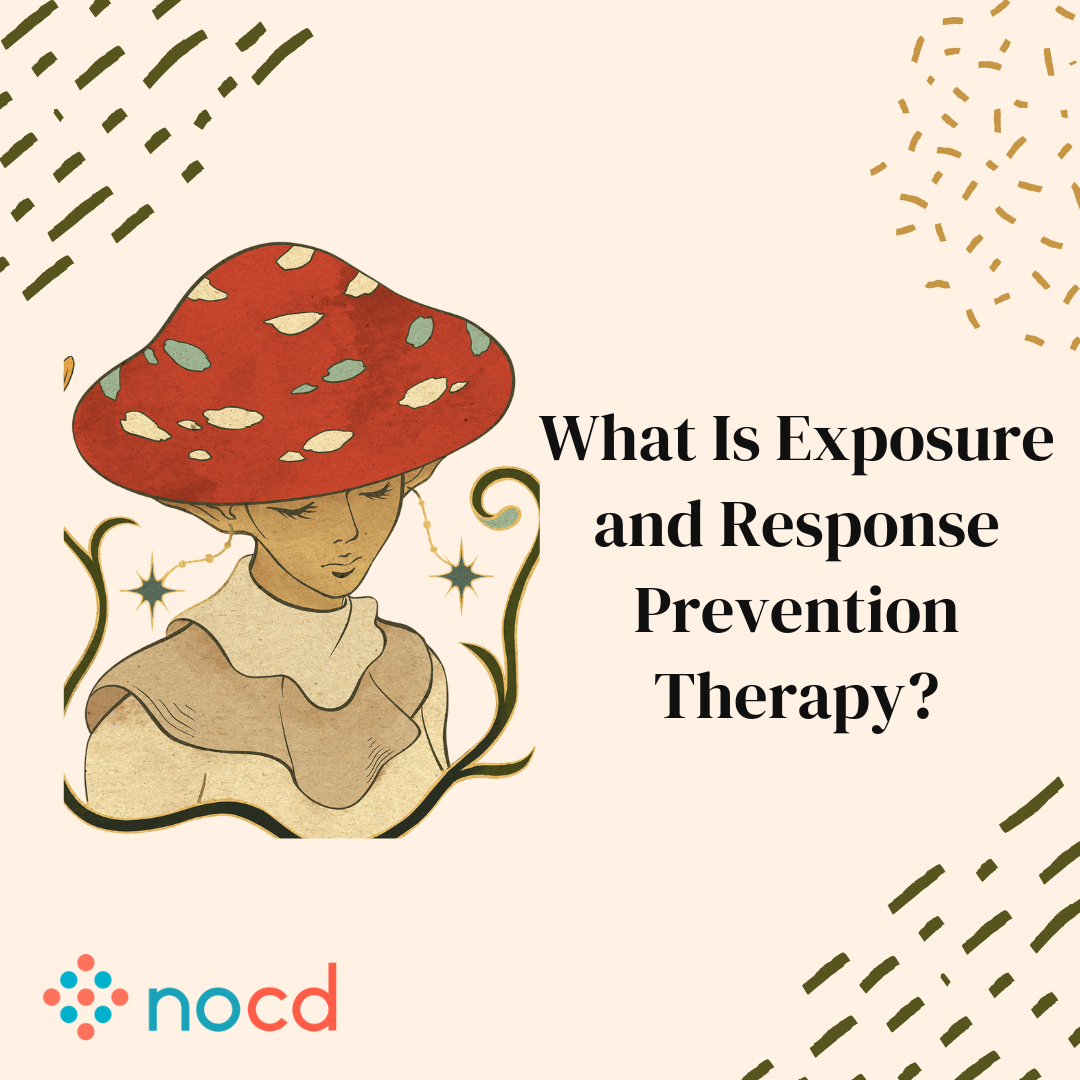
Why is ERP So Expensive? There are hundreds of OCD tests and “OCD quizzes” online. Some aim to help people self-diagnose; others turn obsessive-compulsive disorder into a joke. Either way, a vast majority of these are not helpful and probably create more problems than solutions.